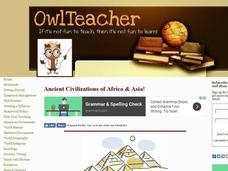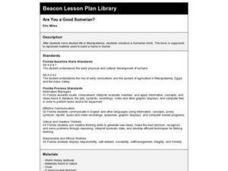Curated OER
Mesopotamian Gods: Handout
Ancient religion was often times closely linked to social structure and government. Hand out a handy guide that describes 12 major gods and goddesses from ancient Mesopotamia. They are each connected to a location, symbol, and force of...
Curated OER
Hammurabi's Code
Here is a narrow view of Hammurabi's code. Without cultural, social, or political context, this presentation asks students what they think of the concept of an eye for an eye. Images of Babylonian artifacts and Hammurabi's laws are...
Curated OER
Interpreting the Evidence
Students find out about the social changes that caused the collapse of important ancient civilizations in Central America, Mesopotamia, the southwestern United States, and western Africa.
Time Warp Trio
The Seven Blunders of the World
Learners explore the cultures and civilizations of Mesopotamia. They take a look at the factors that shaped the region, and study the history of the Hanging Gardens of Babylon, and other ancient wonders of the world. The class is divided...
Curated OER
Life in Old Babylonia: The Importance of Trade
Students read maps and artifacts for information indicating the existence of a trade network in Old Babylonia and beyond. They list goods imported to and exported from Babylonia. They indicate trading centers on a map of ancient...
Owl Teacher
Teach Ancient Civilizations: Africa
Amazing! Teach learners about the wonders of ancient Africa and Asia with a comprehensive set of teaching tools. You'll click to find a well-constructed presentation, a worksheet that has kids compare and contrast ancient alphabets, a...
Curated OER
How to "Read" an Artifact
Middle schoolers discuss the types of information they can get from artifacts. In groups, they practice "reading" artifacts and determining their usage. They use inferences to test against official information about certain pieces. ...
Curated OER
World History Fall Final: Ancient History to the American Revolution
A variety of topics and activities make up this presentation, which prompts viewers to answer questions from the Stone Age to the American Revolution. Note: You may find some slides more useful and pertinent than others.
Curated OER
Reading Time Lines
Sixth graders read and locate events (ranging in time from B.C. to A.D.) on a time line. They will then create and organize events of a timeline of the historical events of Mesopotamia.
Curated OER
Bank On It! Ancient Farming
In this ancient farming learning exercise, learners fill in the blanks in 25 sentences about farming in Mesopotamia. Students will use the words in a word bank. Prior knowledge or research will be needed.
Curated OER
Ancient Civilizations: The Ancient Israelites
Planning a study of ancient Israel and Mesopotamia (1800-500 B.C.)? Here's a resource packet loaded with activities, exercises, worksheets, and background information that integrates social studies and language arts curriculum.
New York State Education Department
Global History and Geography Examination: January 2010
Agriculture was more revolutionary than some might think. Using a primary source set—including photos of artifacts from Mesopotamia and an amusing comic—learners consider the impacts of the neolithic, agricultural, and green revolutions....
Curated OER
Ancient Mesopotamian and Egyptian Writing
Students research cuneiform and hieroglyphics from the internet and use educational software to create their own cuneiform tablet in this excellent World History lesson. The use of the computer software program Inspiration 7.5 is...
Curated OER
Urban Ecosystems 2: Why are There Cities? A Historical Perspective
Second in a series of five lessons, this lesson encourages preteens to consider cities as urban ecosystems. First, they keep a food diary for a few days. They visit the Natrional Agricultural Statistics Service website for current data...
University of California
Interactions in Baghdad and the Abbasid Caliphate
An interesting resource focuses on the cultures of different peoples that have lived in Baghdad and their interactions. Academics view 11 sources to understand how Baghdad has been home to people of many faiths and cultures throughout...
Virginia Department of Education
World History and Geography to 1500 A.D.
Here's a great resource for your curriculum library. The 240-page packet, organized into units by topics, includes sample lesson plans, links to primary and secondary source documents, worksheets, activities, and sample assessments.
Council for Economic Education
The Neolithic Agricultural Revolution
What effect could one person's invention have on the human race? In the case of the Neolithic Agricultural Revolution, small improvements in farming methods led to increased food production. The human population began to boom, leading us...
University of California
Jewish Holidays
Modern Jewish holidays have ancient roots with many connections to today. Using photographs of primary sources, such as fragments of a shofar, as well as texts, such as the Hebrew Tanakh, learners explore how Jewish holidays reflect...
Curated OER
Elements of Civilization
Students create their own ancient civilizations based off of topographical maps of Egypt, Mesopotamia, the Indus Valley, and the Yellow River. In this social studies activity, students are assigned one topographical map to use to create...
Curated OER
Are You a Good Sumerian?
Studetns, after studying life in Mesopotamia, create a Sumerian brick.
Curated OER
Science NetLinks: Collapse 2: Interpreting the Evidence
Young scholars continue to explore the factors that contribute to the collapse of a society; they also explore how archaeological evidence is gathered and interpreted. Students explore about the social changes that caused the collapse...
Curated OER
Visit a Mesopotamian House
Students compare the homes of people who lived in ancient Mesopotamia to their own and explore how climate, natural resources, and cultural differences may have influenced the differences. The house plan can be obtained from the wed site.
US Department of Agriculture
Agriculture Counts
Agricultural survey and the documentation of livestock or goods was the basis for the first written language. Youngsters discuss sorting and counting, and how these skills have been used for thousands of years. They accent their class...
Curated OER
PEOPLE OF THE FERTILE CRESCENT
Students evaluate how technology changed life in Mesopotamia. Students summarize the link between agriculture and religion in Sumer. Students classify the Sumerians according to social classes. Students classify the causes and effects...
Other popular searches
- Ancient Mesopotamia
- Irrigation Mesopotamia
- Historical Maps Mesopotamia
- City States in Mesopotamia
- Ancient Mesopotamia Map
- Mesopotamia Art Projects
- Ancient Mesopotamia Stories
- Mesopotamia City State
- Mesopotamia Projects
- Ancient Mesopotamia Trade
- Geography of Mesopotamia
- History Mesopotamia

























